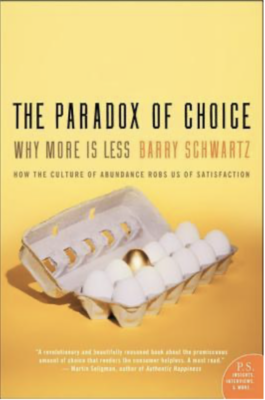The Paradox of Choice – Barry Schwartz

One of the most memorable and important of his theses is dividing people into those who are maximizers and those who are satisficers. They are fairly self explanatory labels but the book does an excellent job of giving examples of the types of behaviors exhibited by both. Maximizers tend to experience anxiety in the process of making choices: they are constantly assessing the “best” of the choices, sometimes paralyzed by considering the options both real and imagined, and often less satisfied with what they choose because of constantly considering all the options that weren’t chosen. Satisficers on the other hand decide what is “good enough” and make their choices based on that standard and then move on. It’s not that satisficers have lower or lesser standards, only that they can make a choice that meets the standard they have set and move forward without second guessing or regretting all the choices that were rejected.
When you grasp these concepts, suddenly you can see these behaviors everywhere. I spent a long weekend in Boston with two long-time friends from high school. I was explaining the book and this particular concept to both Stu and Wayne, who immediately assessed where they were on this spectrum. And it is a spectrum of behavior. Stu is on the maximizer end, I am on the satisficer end and Wayne was somewhere on the spectrum closer to satisficer than maximizer. But as we went through our 4 days together deciding what to do, where to go, what to eat, we were suddenly hyper aware of how we made choices and how that affected our level of satisfaction with the outcome. Being self aware of how we make decisions is key to understanding why we feel the way we do about the results.
Schwartz takes the position that we are overwhelmed with decisions both large and small on a daily basis. The number of choices we are faced with every day is vastly greater than what our parents or grandparents had to face: cellphone plans, 401(k) plans, paper or plastic, smoking or non-smoking, credit or debit, fixed rate or adjustable rate, the warranty plan or not, upgrade to first class, and hey would you like to super size that? We tend to assume that more choice and more autonomy makes us happier. But the research and statistics say otherwise. In countries around the world, the increase in material wealth and standard of living has not made people happier. In fact, the rate of depression and suicide has risen sharply in recent decades in countries like the United States.
Some of this is due to a difference in objective well being and subjective well being. Objectively, it’s easy to measure that we have more of everything – food, medical care, better housing, education, transportation, technology. But subjectively, those things don’t make us feel better. All the time saving devices in the world from dishwashers to computers have not made us feel that our quality of life is better, or that we are somehow happier than our grandparents were.
The book is quite fascinating and I got a lot out of it. The final chapter is suggestions on how to tackle this overwhelming amount of choice and sort out what is worth expending time and energy in deciding, and what is not. Maximizers tend to apply the same of amount of time and energy into choosing just the right coffee maker as they do in buying a car. Some things are not worth the investment of that kind of time, energy and anxiety. We need to adopt different behaviors for the times in which we live and that’s really what this book is all about. I highly recommend it.